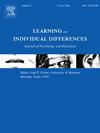小学生自我调节效能的来源转换及其与自我调节效能的关系
IF 9
1区 心理学
Q1 PSYCHOLOGY, EDUCATIONAL
引用次数: 0
摘要
摘要本研究调查了345名小学生在一学年的掌握和替代经验、社会说服、心理和情绪唤醒等自我调节效能源的特征特征的稳定性和变化,以及特征特征成员与性别、学习支持和自我调节效能的关系。潜在特征和转变分析确定了学生的四种特征:高度积极、一般、有压力和高度积极但有压力。在整个学年中,所有的学生都表现出稳定的状态,然而一些学生转变为更不适应的状态。性别与一些档案成员和过渡显著相关,而对学习的支持则无关。高度积极的学生表现出更高的自我调节效能,而处于压力状态的学生则表现出较低的自我调节效能。此外,在学年过渡到更不适应的形象与较低的自我调节效能有关。本研究根据小学生的自我调节效能来源,确定了四种不同的自我调节效能来源:高度积极、一般、有压力、高度积极但有压力。大多数学生表现出积极的自我调节效能源组合,但一些学生的概况更不适应,其特征是相对较高的压力水平。虽然大多数学生在学年期间保持了他们最初的形象,但确实发生了一些转变为不适应的形象。总体而言,这些稳定性和过渡可以预测学生的自我调节效能,因此,表现出更积极和稳定的学生的自我调节效能更高,而属于或过渡到更有压力的学生的自我调节效能较低。这些发现表明,经历压力可能对学生的自我效能感有害,即使他们在其他方面有积极的自我效能感基础(即来源)。本文章由计算机程序翻译,如有差异,请以英文原文为准。
Primary school students' profiles of self-regulatory efficacy sources—Transitions and association with self-regulatory efficacy
This study investigated stability and changes in primary school students' (N = 345) profiles of self-regulatory efficacy sources including mastery and vicarious experience, social persuasion, and psychological and emotional arousal within one school year, and how profile memberships associate with gender, support for learning, and self-regulatory efficacy. Latent profile and transition analyses identified four profiles among students: Highly positive, Average, Stressed, and Highly positive but stressed. All profiles showed stability during the school year, yet some students transitioned into more maladaptive profiles. Gender was significantly associated with some profile memberships and transitions, while support for learning was not. Students who remained Highly positive showed higher self-regulatory efficacy, while students remaining in profiles showing stress reported lower levels of self-regulatory efficacy. Additionally, transitioning to a more maladaptive profile within the school year was related to lower self-regulatory efficacy.
Educational relevance and implications statement
This study identified four different profiles among primary school students based on their self-regulatory efficacy sources: Highly positive, Average, Stressed, and Highly positive but stressed. Most students showed a positive combination of self-regulatory efficacy sources, but some students' profiles were more maladaptive, characterized by relatively high levels of stress. While most of the students remained in their initial profile during the school year, some transitions into maladaptive profiles did occur. These stabilities and transitions, in general, predicted students' self-regulatory efficacy, so that students showing more positive and stable profiles reported higher self-regulatory efficacy, whereas students belonging or transitioning to more stressed profiles reported lower self-regulatory efficacy. These findings suggest that experiencing stress may be harmful for student's self-efficacy, even when they otherwise have positive bases (that is, sources) for self-efficacy.
求助全文
通过发布文献求助,成功后即可免费获取论文全文。
去求助
来源期刊

Learning and Individual Differences
PSYCHOLOGY, EDUCATIONAL-
CiteScore
6.60
自引率
2.80%
发文量
86
期刊介绍:
Learning and Individual Differences is a research journal devoted to publishing articles of individual differences as they relate to learning within an educational context. The Journal focuses on original empirical studies of high theoretical and methodological rigor that that make a substantial scientific contribution. Learning and Individual Differences publishes original research. Manuscripts should be no longer than 7500 words of primary text (not including tables, figures, references).
 求助内容:
求助内容: 应助结果提醒方式:
应助结果提醒方式:


